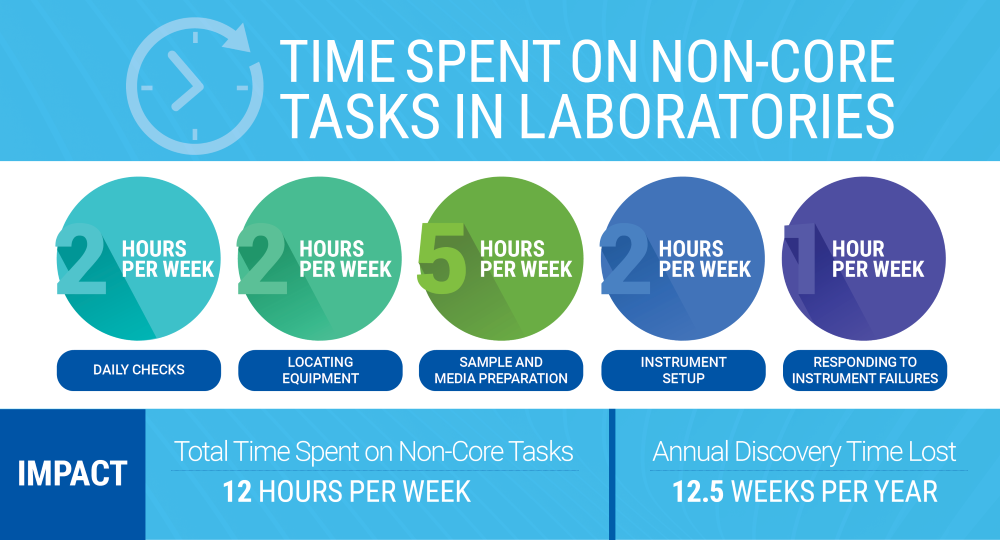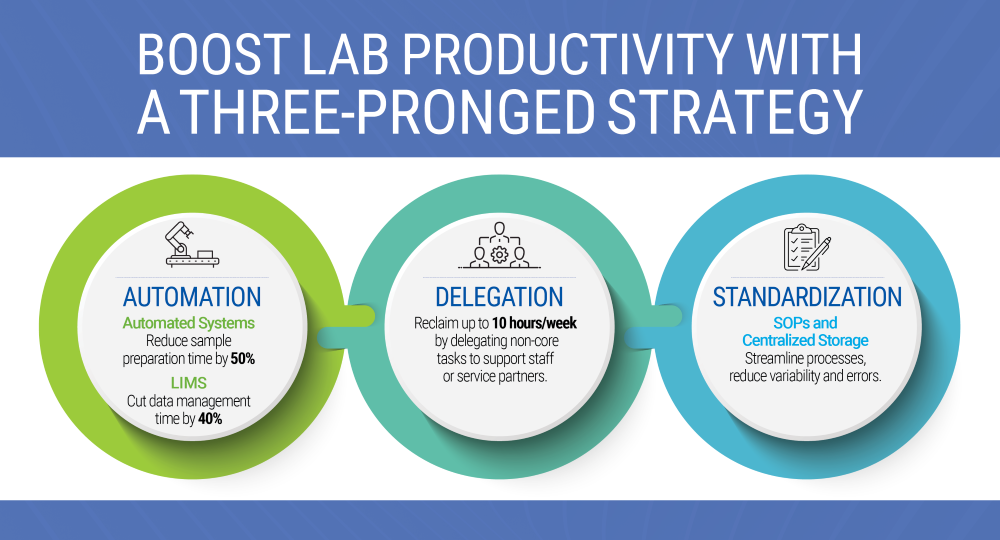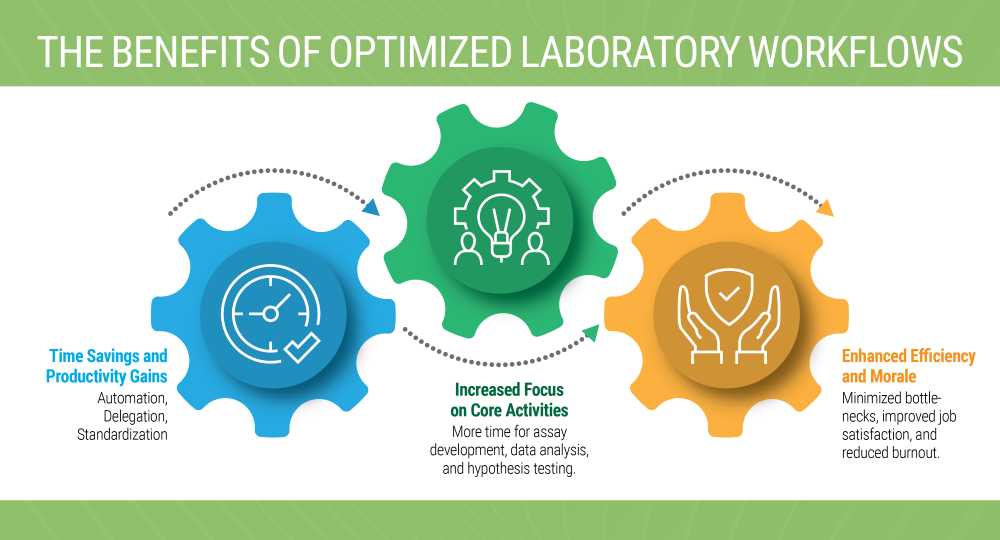09 August 2024 | Friday | Product Spotlight

Source : PerkinElmerblogs
Yet, many scientists find their days consumed by non-core tasks such as reagent preparation, instrument setup, and consumables management. These essential but time-consuming activities detract from core scientific work, leading to decreased productivity and slowed innovation.
This blog will explore strategies to alleviate the burden of non-core tasks through optimized workflows. By implementing a structured approach to laboratory management, labs can free up valuable time for scientists to focus on innovation. Our discussion will delve into practical methods, including automation, delegation, and standardization, to enhance efficiency and productivity in the lab.

The Burden of Non-Core Tasks
In R&D and drug discovery, laboratories involve professionals such as research scientists, validation scientists, cell biologists, medicinal chemists, and computational chemists. These roles share a common burden: non-core tasks that consume a sizable portion of their daily schedule. Here are some specific examples:
Survey data reveals that 42% of lab workers spend over 5 hours per week on administration, compliance, and validation workflows. 40% spend 3-4 hours per week on quality control procedures. For instance, a research scientist might spend hours preparing reagents and setting up experiments, time better spent on analyzing results and accelerating drug discovery.
Further data shows that each scientist loses an estimated 12.5 weeks (about 3 months) of discovery time annually due to non-core tasks:
These non-core tasks account for a huge portion of a scientist’s weekly schedule, leaving approximately 28 hours per week for core discovery activities. This diversion of focus can slow down scientific discoveries and hinder innovation. The repetitive nature of non-core tasks can also lead to burnout and reduced job satisfaction, impacting the overall efficiency and morale of the laboratory team.
Evaluating and Optimizing Workflows
Evaluating laboratory workflows is crucial for identifying inefficiencies and optimizing operations. By taking a systematic approach to analyze current processes, laboratories can pinpoint bottlenecks, streamline tasks, and enhance overall productivity. This proactive assessment is essential for freeing up valuable time for scientists to focus on core research activities.
Methods for Assessing Current Workflows
Identifying Bottlenecks and Inefficiencies
Through workflow evaluation, laboratories can identify specific bottlenecks and inefficiencies that hinder productivity. For example, if time tracking reveals that a significant amount of time is spent on instrument setup, this indicates a potential area for automation or delegation. Similarly, process mapping may uncover redundant steps in sample preparation that could be streamlined.

Implementing a Three-Pronged Strategy
To maximize laboratory productivity and minimize the burden of non-core tasks, implementing a three-pronged strategy—automation, delegation, and standardization—can be highly effective. Here is a closer look at each component:
Automation: Leveraging Technology to Automate Repetitive Tasks
Delegation: Utilizing Support Staff or Scientific Service Partners for Routine Tasks
Standardization: Creating Standardized Protocols to Streamline Processes
By integrating automation, delegation, and standardization into laboratory workflows, labs can significantly reduce the time spent on non-core tasks. This approach enhances overall productivity, improves the quality and consistency of scientific work, and boosts morale and job satisfaction among lab personnel.

Potential Benefits and Estimated Impacts
Implementing the three-pronged strategy of automation, delegation, and standardization has led to significant benefits in laboratory efficiency and productivity:
With the reduction of non-core tasks, scientists have more time to dedicate to core research activities such as assay development, data analysis, and hypothesis testing. This shift has led to faster project completion and increased pipeline of potential therapeutics. Streamlined workflows have minimized bottlenecks and eliminated task duplication, improving overall lab efficiency, and enhancing the quality and consistency of scientific output. Additionally, the alleviation of repetitive tasks has prevented burnout and boosted job satisfaction among lab personnel, contributing to a more motivated and productive team.
The Role of Scientific Service Partners
Scientific service partners play a crucial role in enhancing laboratory productivity by taking on non-core tasks and providing specialized expertise. These partners act as extensions of the laboratory team, offering a range of services that allow scientists to focus on their core research activities. Here is how they can support laboratories:
Practical Tips for Reducing Non-Core Tasks
Step-by-Step Guide to Identifying and Categorizing Tasks
To effectively reduce non-core tasks and optimize laboratory workflows, it is essential to identify and categorize the tasks that consume considerable time. Here is a step-by-step guide:
Tips for Selecting the Right Service Partners
Selecting the right scientific service partners can significantly reduce the burden of non-core tasks. By following the steps to identify and categorize tasks, and carefully choosing reliable service partners, laboratories can streamline their operations, allowing scientists to focus more on core research activities and innovation.
Conclusion
Maximizing laboratory productivity and innovation requires a strategic approach to minimizing non-core tasks. By understanding the burden these tasks place on scientists, evaluating workflows, and implementing a three-pronged strategy—automation, delegation, and standardization—laboratories can significantly enhance lab efficiency.
The journey towards optimized laboratory workflows begins with a thorough task audit and categorization. Identifying the tasks that consume valuable time and finding ways to automate, delegate, or standardize them can free up scientists to focus on core research activities. The potential benefits, including increased productivity, improved morale, and faster scientific progress, make this effort worthwhile.
For a more detailed exploration of strategies to maximize laboratory productivity, we encourage you to download our eBook, “MAXIMIZING LABORATORY PRODUCTIVITY WITH PROFESSIONAL SCIENTIFIC SERVICES.” This comprehensive guide offers actionable insights and practical tips to help your laboratory thrive.
Ready to transform your lab? Contact us to get started!
© 2025 Biopharma Boardroom. All Rights Reserved.